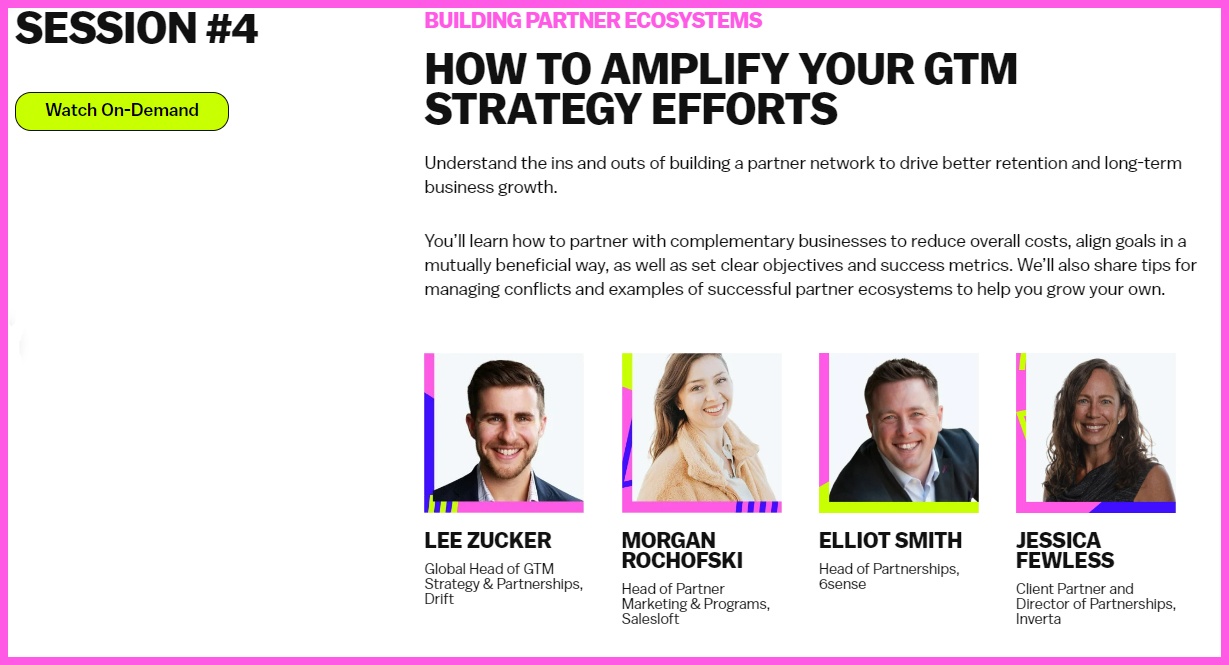When it comes to complex B2B software, on average, it takes 27 touches to close a deal. But, regardless of whether your buying cycle is long like that or mercifully shorter, at every stage of the journey, some leads will drop off.
The truth is, while you will be able to convert a certain percentage of your leads (which depends on what you’re selling and the state of the market), you’ll never convert all of them.
So, the more leads you have, the better. Because while it’s important to nurture and convert as many leads as possible, it doesn’t hurt to know you’ve got a steady stream of new leads on the way.
But how do you generate leads effectively and efficiently? What really works?
We’ve chatted with our own pro marketers at Drift to create a list of the most effective lead generation strategies for businesses today. Regardless of your budget or your marketing prowess, we promise there’s something here for everyone.
Let’s dive in ⚡
What Is Lead Generation?
Lead generation refers to the marketing strategies that companies use to acquire new leads.
While most B2C brands focus their marketing on acquiring new customers as fast as possible, companies with more complex sales processes need to generate leads and nurture them over time. B2B software companies, professional service providers and consultants, construction companies, and insurance agencies are all examples of businesses that need to do this.
The more expensive the offer and the more considered the purchase, the more important it is for you to generate lots of leads, as only a portion of your leads will convert into paying customers.
That’s why strategy matters. Because the right lead generation strategies will help you drive low-cost, targeted leads that you can then nurture through a combination of marketing automation and high-touch sales.
15 Great Lead Generation Strategies
Need a reliable way to generate fresh leads? Here are 15 proven strategies that today’s marketers use to create interest for their brand and engage potential buyers.
1. Account-Based Marketing (ABM)
Account-based marketing is a strategy where you treat your top ideal customers to extra special experiences through targeted campaigns and personalized outreach with the goal of converting them. Think a VIP wine-tasting event, a customized gift, or even a highly-tailored cold email.
One of our more successful ABM campaigns at Drift was when we sent a pair of AirPods and a high-quality microphone to our top target accounts. The theme of the campaign was all about having better conversations, which tied the gifts back to our product and helped us close some high-value deals.
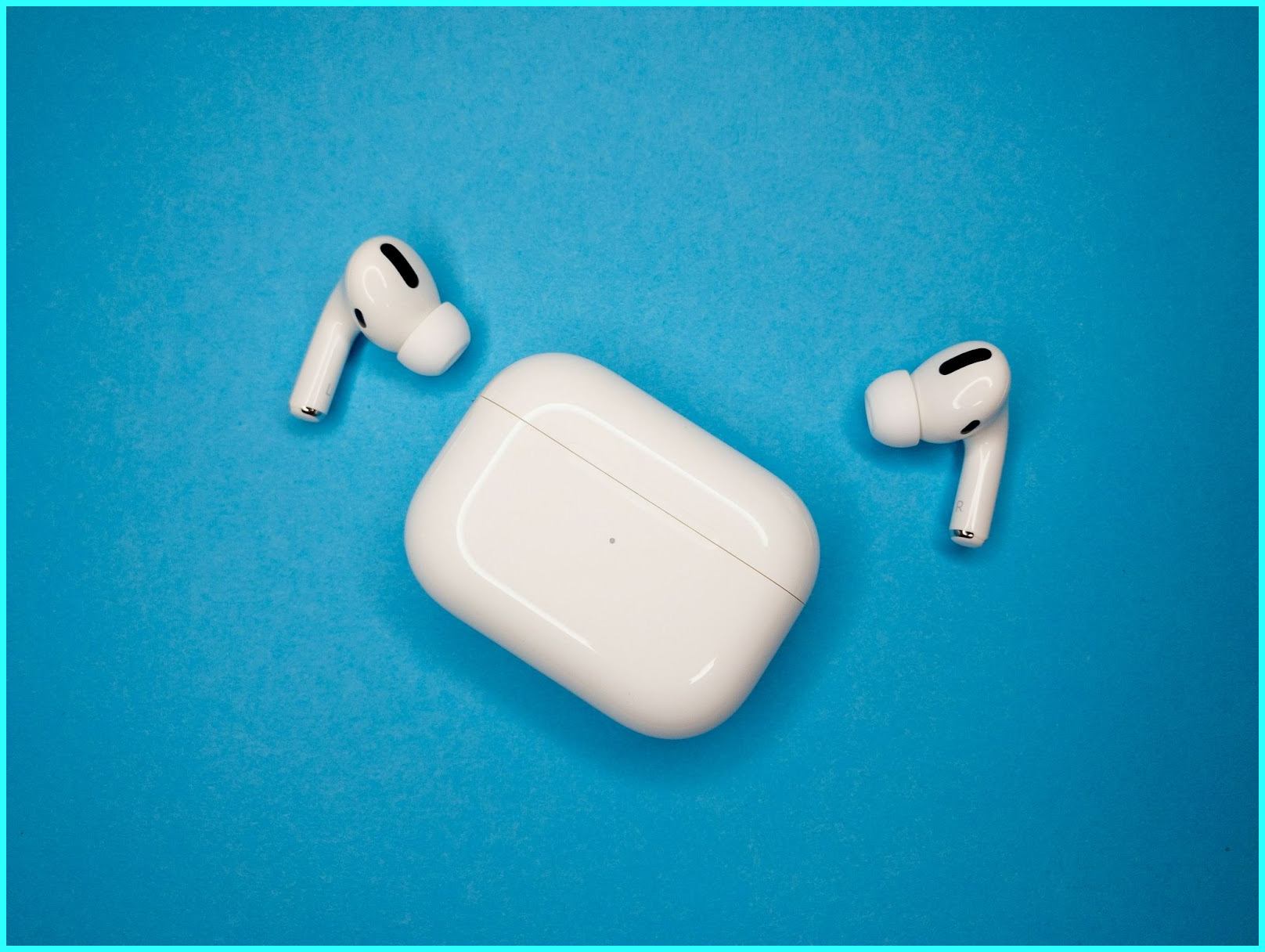
With all of its moving parts, launching an ABM strategy can prove complex. Our favorite ways to get immediate wins is by using our own platform to power our ABM campaigns. With Drift, you can identify when a high-priority account is on your website so that you can ensure your chatbot routes in the right person for a conversation or alert the dedicated sales rep so they can jump in for a live interaction. Plus, all that conversational data is stored so that reps can easily spot what accounts are interested in and understand their immediate pain points.
Check out our ABM Playbook to learn more about how you can create a truly personalized experiences by leveraging intent data.
2. Influencer Marketing
The influencer marketing industry grew from $1.7 billion in 2016 to $16.4 billion in 2022 — and it’s showing no signs of stopping. Instead of creating content and posting it on their own profiles, brands of all sizes are leveraging social media by investing in influencer relationships.
For example, check out this YouTube video by Matt Ferrell. He kicks off an update on his solar panels with a mention of Policygenius, a platform for comparing and buying various types of insurance policies. The video description links to a landing page where people can get quotes — and Policygenius can collect leads.
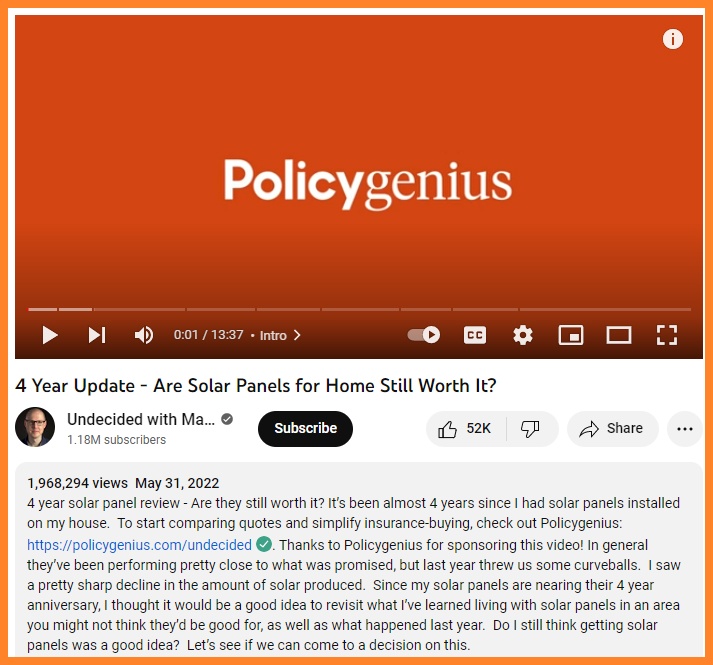
If you’re looking to try influencer marketing, expect to agree upon an upfront fee for the content, be it a single image and caption or a series of short videos. Also consider giving influencers a unique coupon code or landing page link so you can more easily track which influencer content led to leads and sales.
Don’t be quick to dismiss influencers for B2B marketing as well. There are influencers across dozens of industries and roles on LinkedIn, Twitter, and YouTube who can help you reach any professional audience. And if you’re trying to reach small business owners, you can always find influencers to partner with on platforms like Instagram and TikTok.
3. Website Personalization
Personalization makes people pay attention. In fact, 97% of marketers that use personalization state that it has improved their results.
No surprise there. After all, when you personalize your website, you’re catering to people’s unique needs, interests, behavior, and preferences, which drives an experience that better serves your buyers and customers.
So, what better way to personalize your website than with a real-time conversation? Through custom chatbots, you can personalize your website at scale based on who the site visitor is and where they are on your website. For the best results, you can use buyer behavior to trigger more tailored conversations. In this example, the chatbot engages a recent webinar attendee by offering up a replay link.
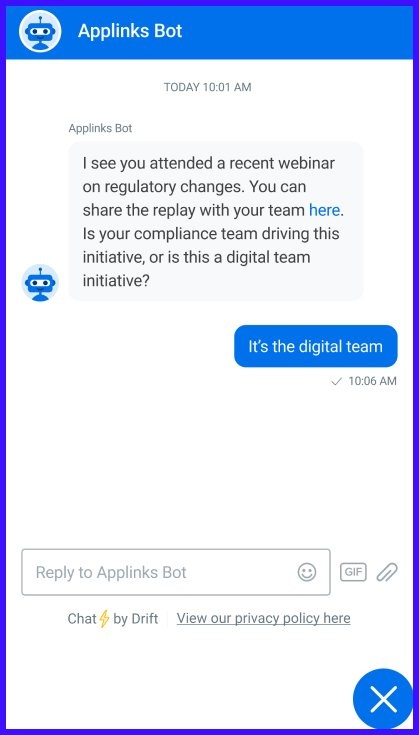
The chatbot then asks a follow-up question in order to get them to share information about their company. Not only do such conversations help generate more leads, but it also gives you an opportunity to nurture those leads as well. After the visitor has responded, a sales rep can take over if one is available or the chatbot can continue to engage them with content and direct them to product or pricing pages for more information.
4. Virtual Events
Even post-pandemic, virtual events are still on the rise. The virtual event industry is predicted to grow at a compound annual growth rate (CAGR) of 21.4% from 2022 to 2030.
That’s because, with virtual events, you can gather a big group of people that match your target audience — without anyone having to fly anywhere.
For example, our GTM Lab: Chain Reaction event consisted of a week of informative sessions featuring speakers on go-to-market strategy, team collaboration, and customer insights. For this event, we brought together GTM leaders from various companies to ensure the content would be highly valuable for all attendees.
You can use these kinds of events to generate leads in a variety of ways, such as by sending follow-up emails before and after the event or having a chatbot that attendees can interact with live during the sessions. As a result, virtual events can improve:
- Your marketing ROI: Compared to an in-person event, virtual events allow you to save money while generating more attendees (due to the convenience of attending).
- The relevance of your experiences: In a virtual event, it’s easier to put on micro-events and host a variety of small sessions. This makes it so attendees can register for the events that most fit their needs and not waste time on content that’s irrelevant to them.
- Your buying cycles: The more leads learn about the positive outcomes of your solution, the faster they’ll get the purchase approved. With the ease of producing virtual events, you can experience this benefit more consistently.
Ready to spark conversations with your virtual events? Learn how to integrate Drift with your virtual events so you can convert more registrants into leads.
5. Interactive Content
The best lead generation campaigns often have a star piece of content at their center.
We’re talking quizzes, templates, calculators, self-audit guides, assessments, and tools that are good enough to pay for. Interactive content can go viral, get shared widely, rank in search, and make your paid advertising campaigns more successful.
In this example, Erika Holmes, a copywriter for personal brands, helps people discover their brand’s “It Factor.” Everyone who takes the quiz becomes an email subscriber who she can keep in touch with through newsletters or personalized follow-up emails.
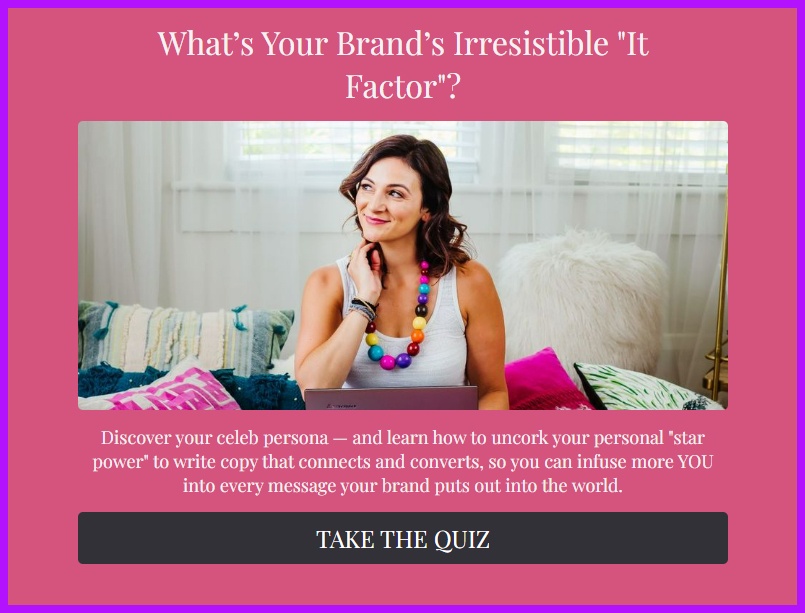
Interactive content can be hard to come by, especially in the B2B world — which makes it the perfect tool for generating leads. If you’re in need of some inspiration for your own interactive content, check out our ROI calculator and Test Drive tool.
6. Conversational Marketing
Conversational Marketing allows you to engage website visitors at all times with real-time conversations using chatbots and live chat. This means you can deliver an experience that meets visitors where they are by asking them if they need help, answering their burning questions, and sending them resources based on their previous activity.
By responding to your site visitors’ needs faster than your competitors, you’ll drive more leads indirectly (a better customer experience = more time spent on your site and more pages viewed) as well as directly (by using your chatbot to ask leads for their contact info).
In this example, Zenefits uses a Drift chatbot to offer a concierge-like experience that allows visitors to choose what content to interact with next. The bot also uses AI so that it can answer any question that’s thrown its way, which ensures that no visitor is left hanging.
With the power of great conversations happening 24/7 and at scale, you can drive more leads from your website to your sales team. Plus, you can collect email addresses and lead information in a conversational way, which makes for a more authentic and human experience.
7. Search Engine Optimization (SEO)
Anytime you search something in Google and click on an organic result (not an ad), that’s search engine optimization at work.
SEO is one of the best digital lead generation strategies out there because it generates a high ROI; once something’s ranking, it can hold its spot for months or even years — leading to tons of high-intent traffic flooding your site.
EnergySage ranks organically for “solar installation California” with a landing page that features estimated out-of-pocket costs, links to solar companies in major California cities, resources for California homeowners, and answers to frequently asked questions.
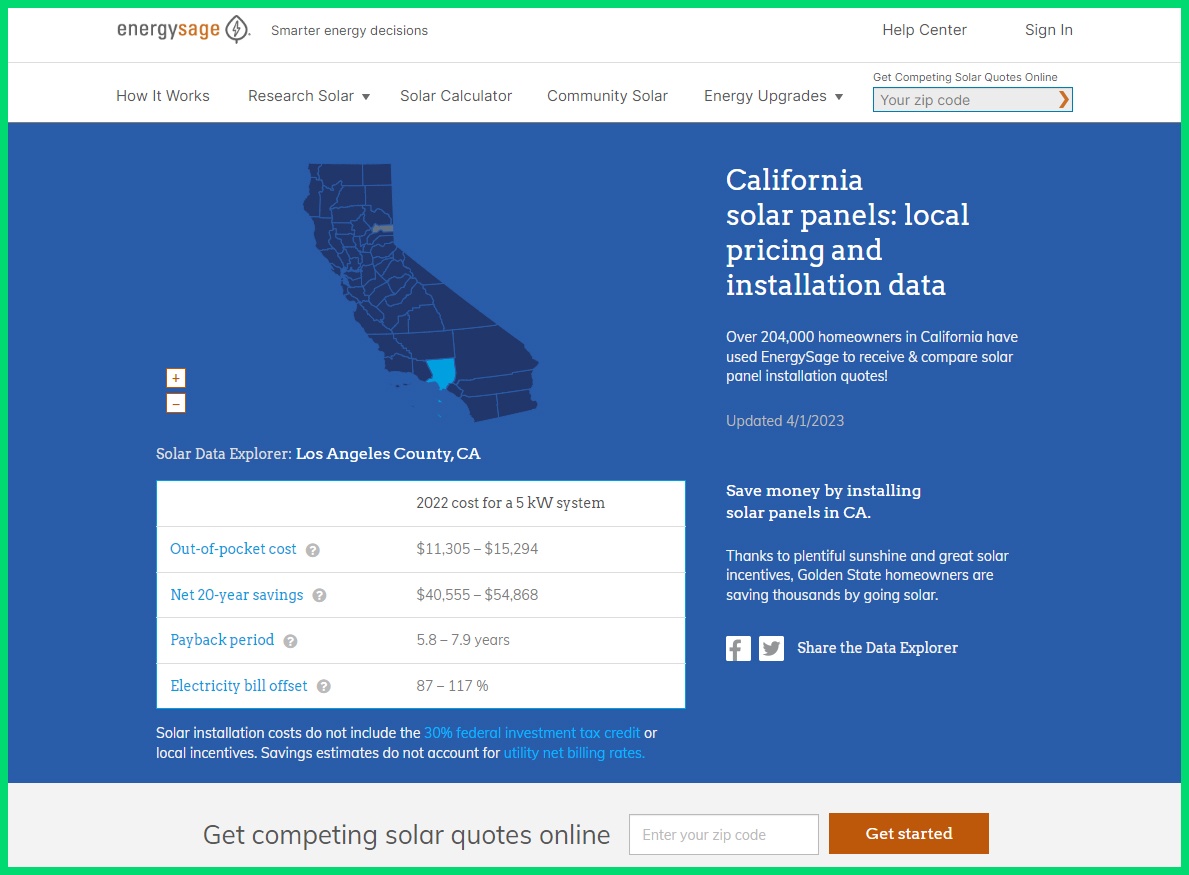
The page generates leads with the CTA, “Get competing solar quotes online.” EnergySage is then able to resell those leads to pre-vetted solar installers.
To have a shot at valuable rankings that will drive leads around the clock, it’s important to do the following:
- Create optimized content: Research ideal keywords and keyphrases using an SEO platform and create content for your top choices. For each keyword or keyphrase, you can build a landing page with product information, an FAQ page, or a long-form blog post. Don’t forget to include some way to capture leads on those web pages.
- Drive high-quality backlinks: Establish your authority with search engines by getting backlinks to your website through guest posts and podcast appearances (more on this in the section on digital PR).
- Improve your site’s speed and UX: Search engines do their best not to rank low-quality sites to ensure they’re providing a trustworthy experience to searchers. So make sure to audit your site for load speed and usability regularly.
As the saying goes, SEO is a long game. But, given all the leads you can drive with a successful SEO strategy, it’s one that is more than worth it.
8. Email Newsletters
These days, it’s not uncommon for people to have tens of thousands or even hundreds of thousands of unopened emails in their inbox.
But there are some emails that you always open, right? Chances are there a couple of email newsletters that never fail to catch your attention. By creating your own eye-catching email newsletter, you can deliver valuable content to your audience and drive tons of leads.
Writing instructor David Perell teaches people how to get their ideas out there and grow their online audiences with email newsletters, Twitter, and Medium articles. His newsletter landing page showcases compelling social proof (over 70,000 subscribers), descriptions of what the newsletter covers, and examples of past content.
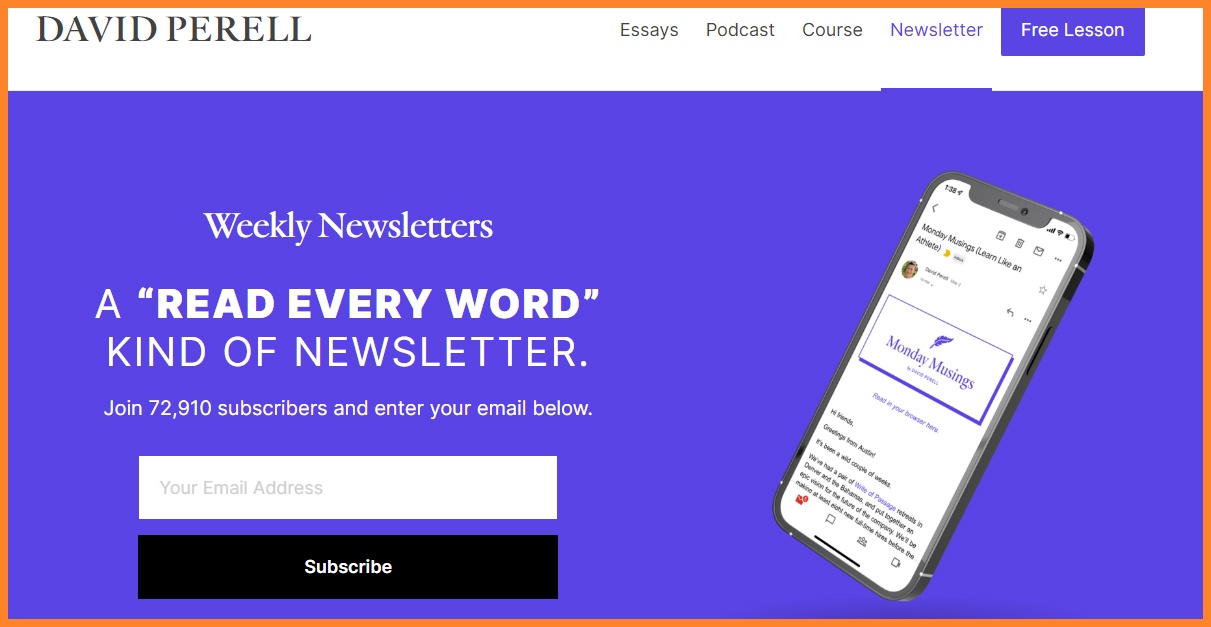
David drives traffic from his large social media and Medium followings to this page, which then generates leads for his writing courses. He also uses his emails to give writing tips and poke at the pain points that are common for people trying to build an online audience. The example below hits on what it feels like to be the retweeter not the tweeter (and the email later pitches his writing course to help people solve this conundrum).
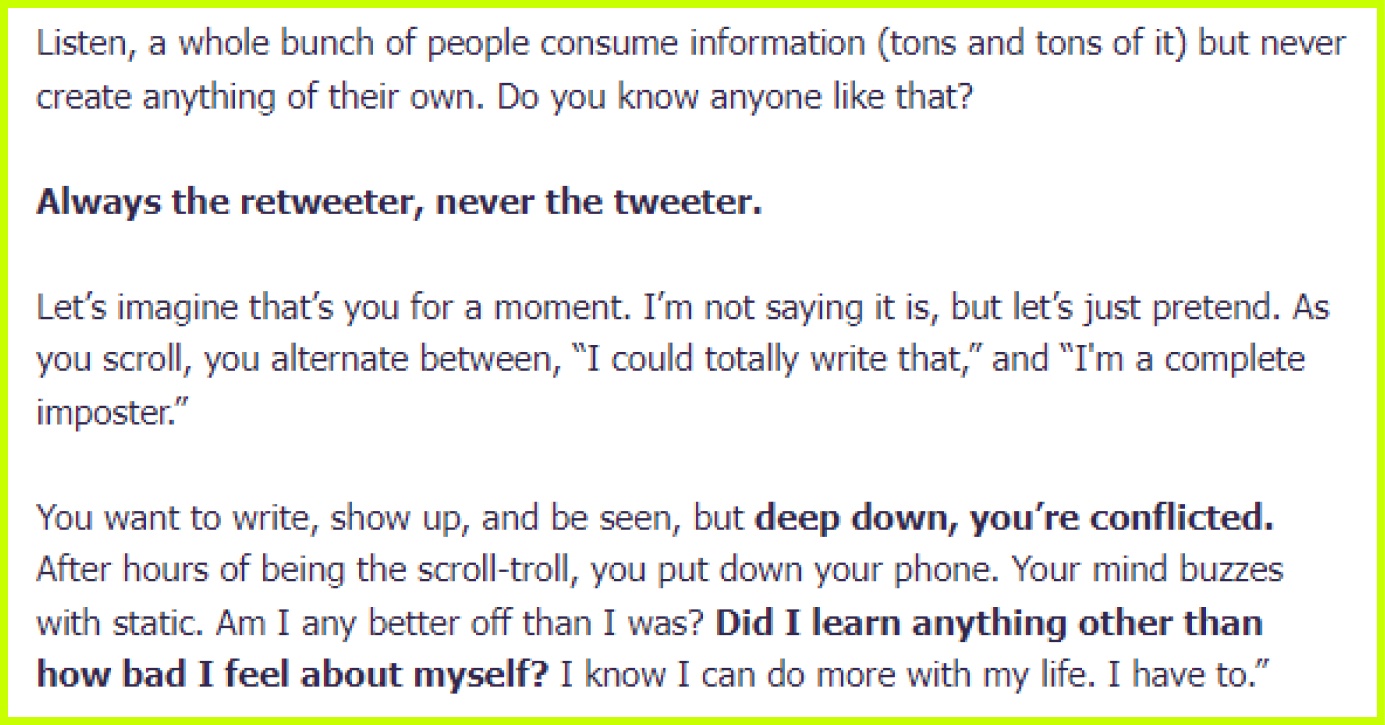
This just goes to show that email is not only a great way to keep in touch with leads but, if your content is good enough, it can also serve as a way to drive new leads.
Crafting your own newsletter? A good tip to keep in mind is to make sure each email includes a link to sign up, so you can easily get more subscribers when someone forwards your newsletter. (Want to see a B2B newsletter in action? Subscribe to one of our own newsletters!)
9. Organic Social Media
Today, Facebook boasts nearly 3 billion monthly active users, while Instagram has 1.35 billion and TikTok has 834.3 million. Social media offers limitless potential, which is why cultivating a social media following has now become a popular lead generation technique.
But with all that potential comes a ton of competition. Newsfeeds are noisy, and bad content dies a swift death in picky algorithms. So, what’s the best way for your business to leverage social media successfully?
Project management platform ClickUp uses their Instagram account to share productivity stats, product tips, and funny videos that appeal to their broad audience of business owners and professionals.
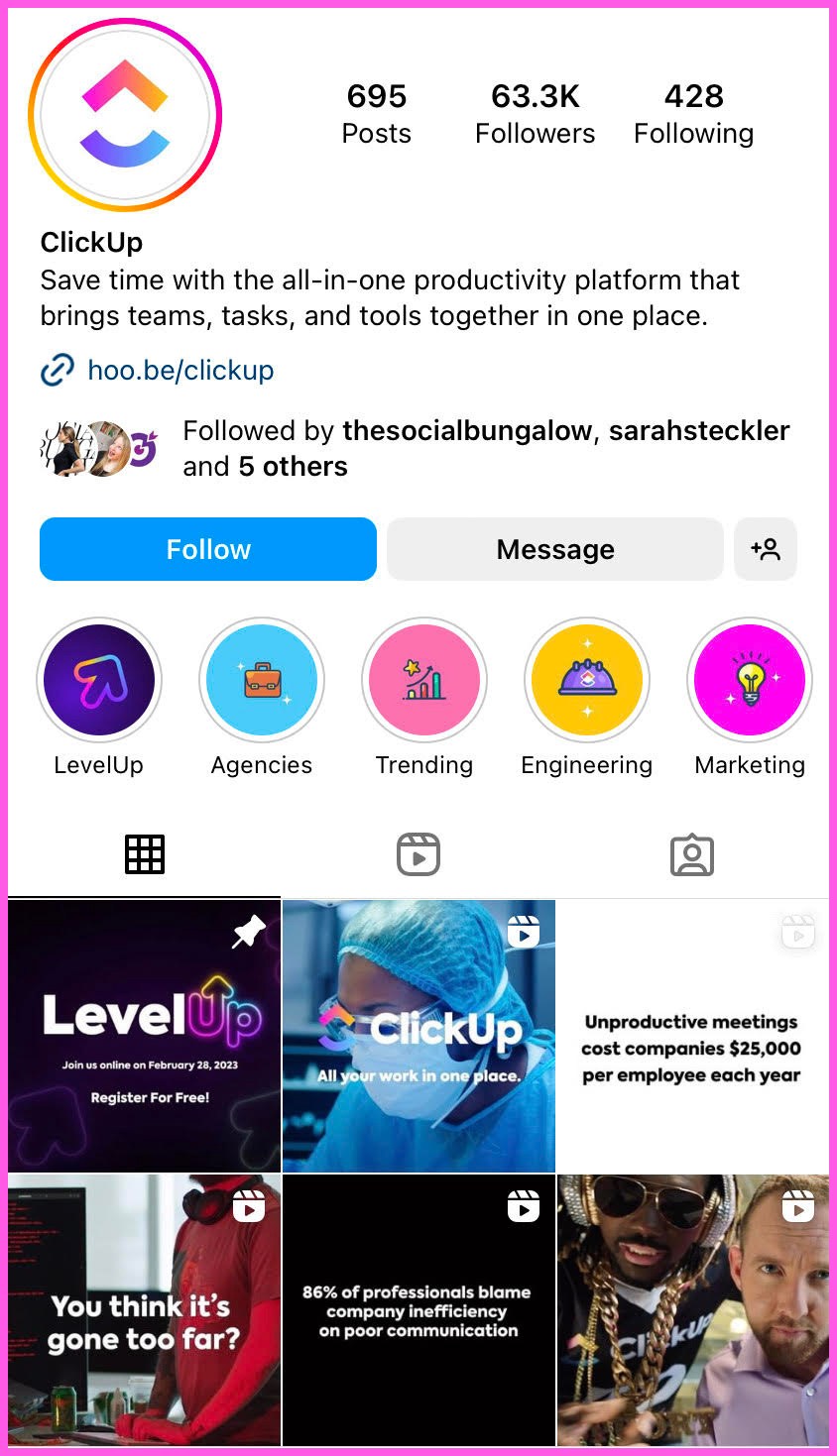
Through Instagram, ClickUp drives traffic to their home page, where users can sign up for a free account and start using their software. This allows for more product-led growth for the company, as a percentage of those free users will ultimately become paying customers. (Keep scrolling for more on product-led growth.)
10. Pay-Per-Click (PPC) Advertising
Organic growth can take a long time to achieve. But PPC advertising can offer more immediate results, as well as clearer ROI, by allowing you to calculate what you spent compared to the average value of the leads generated.
With PPC advertising in particular, you’ll want to make sure that the landing pages you send people to are highly optimized. For example, NerdWallet sends paid traffic for terms like “small business loans” to a clean and simple workflow where users can select various options and see offers that fit their needs.
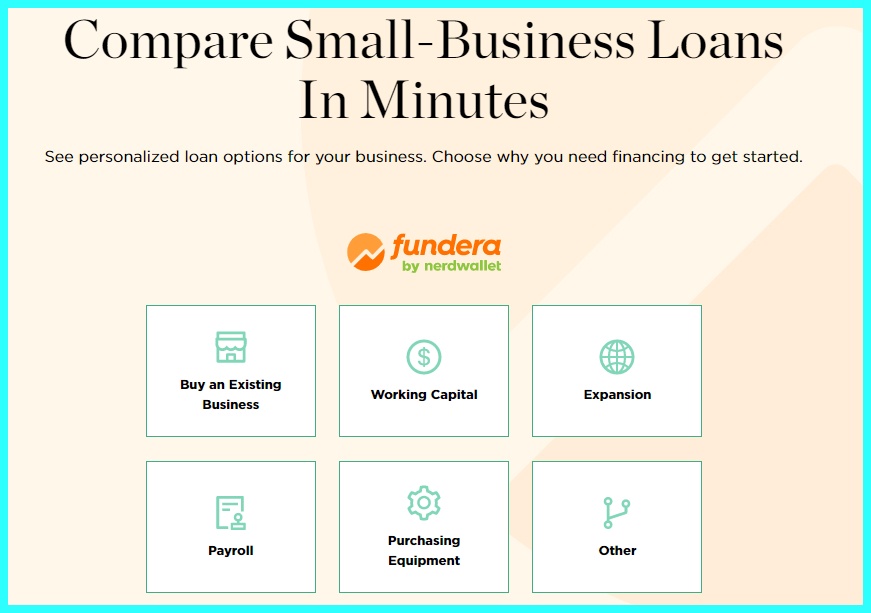
The best part is that PPC pairs well with many of the other lead generation tactics mentioned here. For instance, you can use LinkedIn ads to drive traffic to a newsletter sign-up page or rely on Google search ads to deliver more leads from a high-converting template, tool, or quiz.
11. Digital PR
Digital PR is an excellent way to generate leads for several reasons. You can get in front of niche online audiences that are even more valuable than traditional or local press exposure, gain access to ideal audiences without having to travel for appearances, and generate valuable backlinks to your content as part of your SEO strategy.
Not to mention, digital PR is extremely versatile. Taking part in online summits and conferences, getting online news features, and publishing guest posts all fall into the realm of digital PR.
One of our favorite examples of digital PR in action is to go on a podcast tour from the comfort of your own home. For example, SEO strategist Chima Mmeje has discussed her topic cluster strategy on numerous podcasts including Empire Flippers and Rankable.
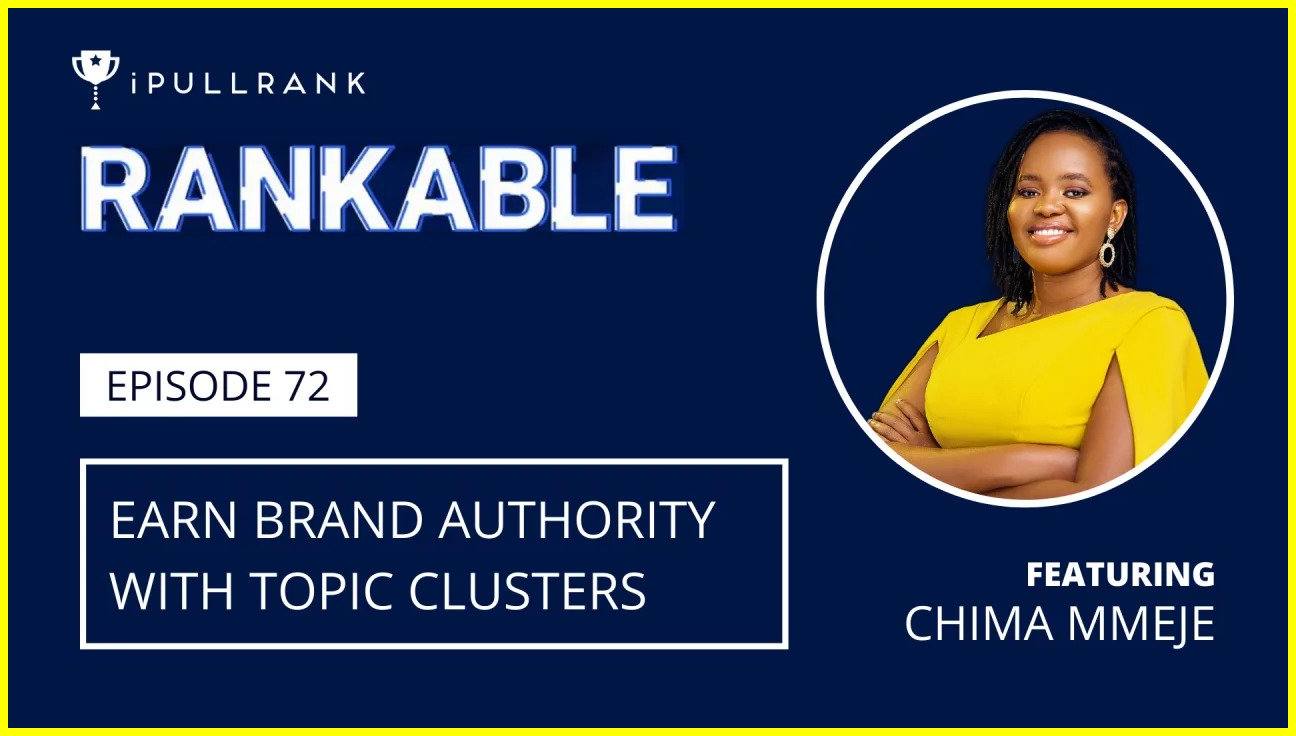
Of course, you don’t have to reinvent the wheel here. Come up with your number one tip to help customers get better results, then share it across different podcasts to reach new audiences and drive fresh leads. Just make sure to update your advice every year or so, or as your business changes. If you do this, you’ll be able to solidify yourself as an expert in your area, drive leads from podcast listeners, and gain backlinks to your website from show notes.
12. Partnership Marketing
The best way to leverage existing audiences is to partner with companies in the same space.
The most common format of partnership marketing is content collaboration, like a joint webinar, co-branded course, or ebook. Here, the depth of the partnership can vary: Sometimes, both companies promote the content and share the leads generated. Other times, only one company will get the lead data while the other simply gets exposure to a new audience.
However, there are many different ways that partnership marketing can manifest. Design Pickle and Bonjoro wisely created a landing page for their partnership. Not only does the landing page showcase their fun-loving side, but it does so while explaining what each company does and how their services work together to unleash creativity and personalization in sales.
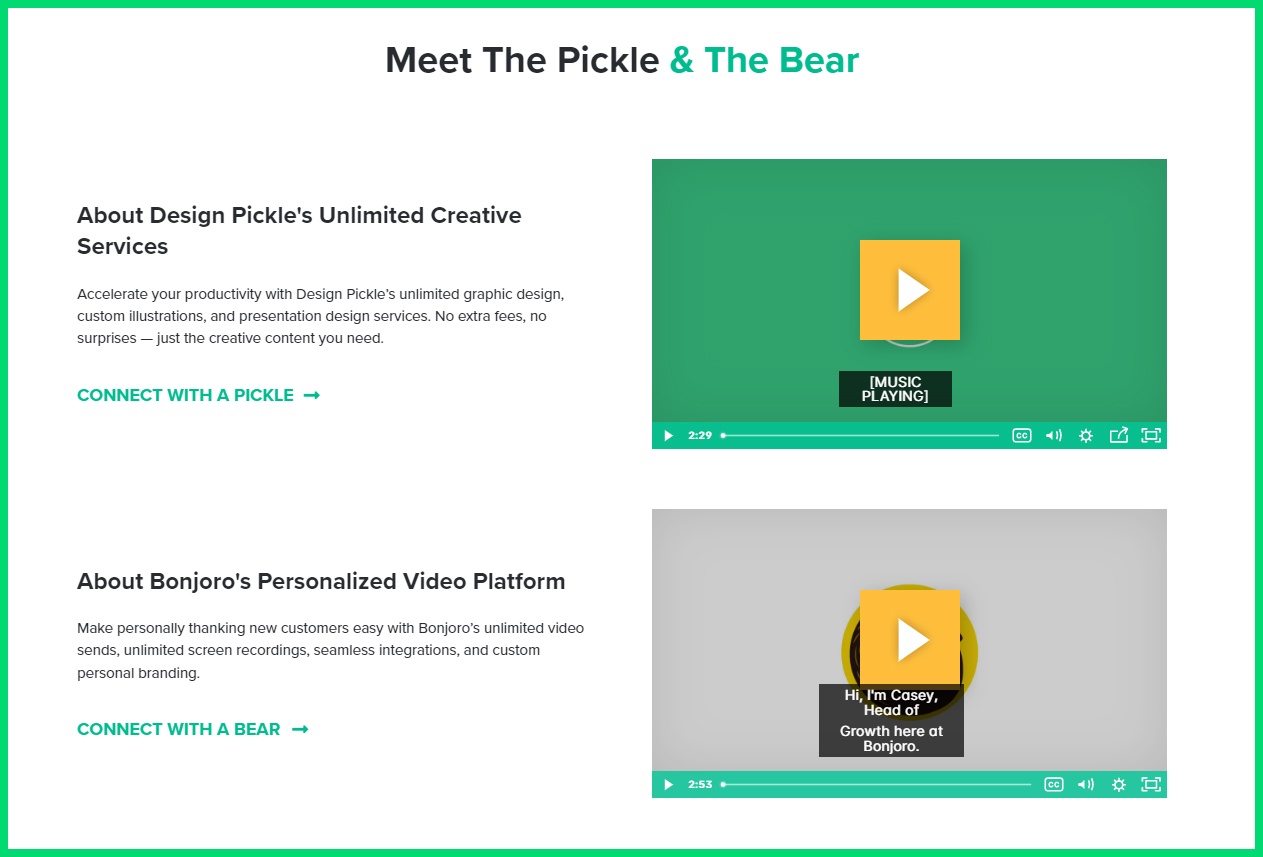
Bonjoro and Design Pickle both link to this hub page from social media, email, and blog content that relates to their partnership. This way, their audience always has somewhere to turn to in order to learn how to maximize their use of these two solutions.
13. Sponsored Content
Beyond partnerships, you can also pay for access to existing audiences.
Sponsored content is great for when you want to leverage online communities, associations, and other organizations. Many such groups already have established sponsorship programs with different tiers. For instance, you might pay a flat rate for the year to submit a certain number of sponsored social media posts, email blasts, and blog posts.
In this example, interior design software provider DesignFiles is using a sponsored email to the Interior Design Society to attract leads to their website with a link to their moodboard training video.
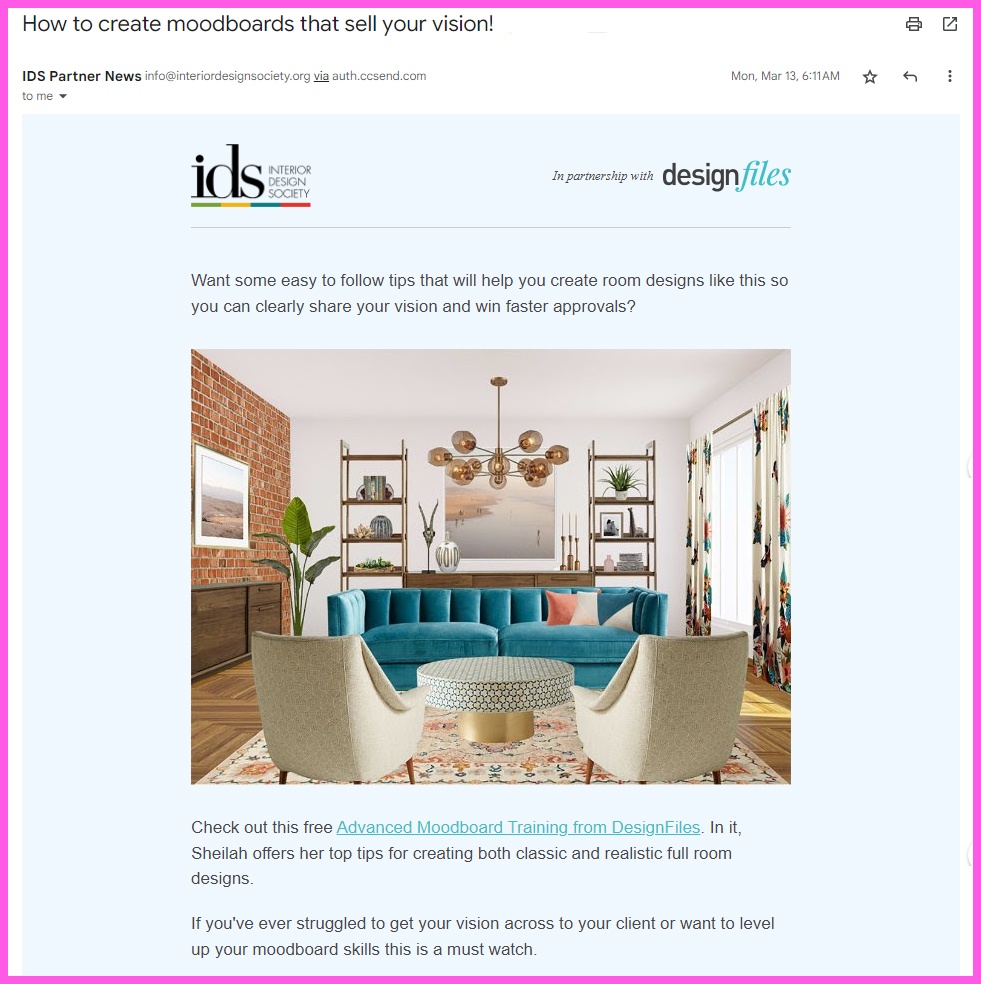
If you’re considering sponsorships, make sure to assess that community’s actual reach. Many organizations will boast high newsletter subscribers, but what really matters is the typical open rate. So, make sure to inquire about how many views their content typically gets.
You should also divert traffic from sponsored content to specific offers or resources. You’ll want a very clear call to action like “watch this training” or “sign up for a free trial” so that you actually generate leads, not just create brand awareness.
14. Product-Led Growth
Product-led growth lets your product do the talking. For this to work, first, make sure that your product is so great it can sell itself. Then, give people a little taste so they will be more likely to buy the full version.
This strategy is most commonly used in the software space. By offering a free trial or freemium pricing structure, SaaS companies lure users into trying out their platform, and then they work to convert them into paying customers using premium features.
Free users can be converted through automated in-app experiences. Take, for example, the “Upgrade” button at the top right-hand corner of Lucidchart, a diagramming tool that gives free users access to all templates and up to three active documents at a time.
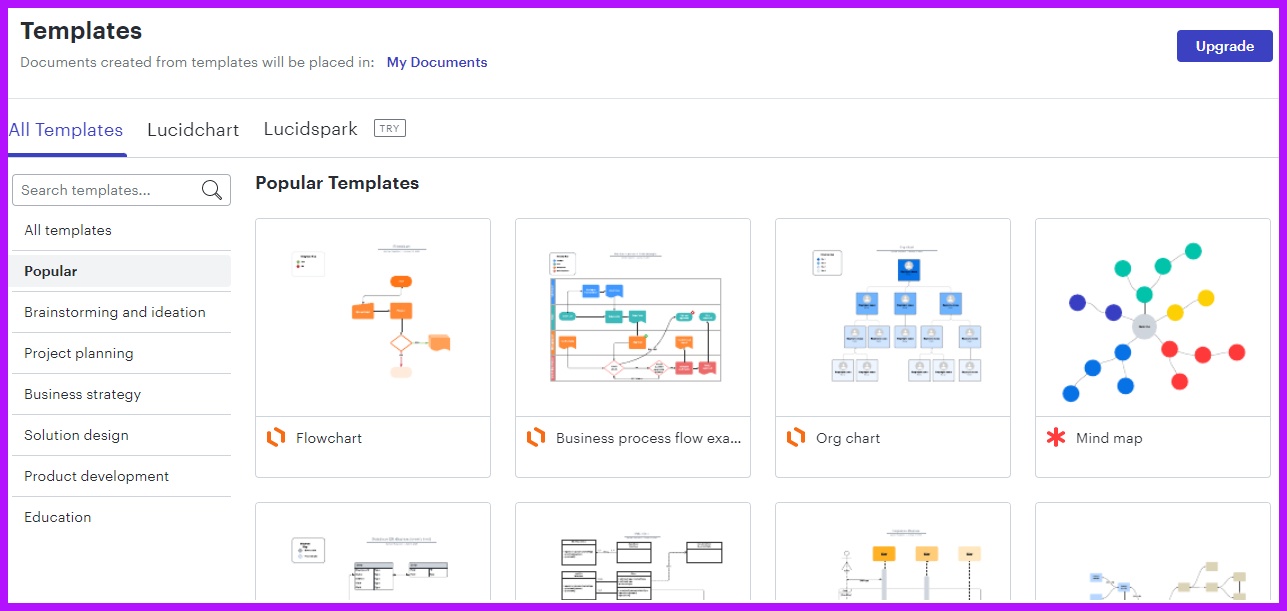
This strategy isn’t just for B2B SaaS companies though. Marketing agencies can offer free audits or tools, and ecommerce companies can give away free samples.
On average, 9% of free accounts convert to paid accounts, which is considerably higher than many other lead generation marketing strategies (for example, display ads convert at 0.55% on average). This is because someone who signs up for a free trial or plan has a higher intent of becoming a customer than someone that’s just engaging with your content or ads.
In addition, product-qualified leads (PQLs) who have used your product a certain number of times or engaged with certain features can be passed along to your sales team for personalized follow-up. So, no matter what you’re selling, it will certainly pay off to make use of this strategy.
15. Employee Advocacy
When your employees are the ones posting about your business on social media — as opposed to influencers — it’s known as employee advocacy. And this can be an extremely effective lead generation strategy.
Why? Because your employees likely have a following that matches your target audience, which means you’re more likely to successfully engage leads through their social posts. Think beauty brand employees that post skin care tips, for example.
B2B companies in particular have a lot to gain from this strategy. B2B social media is notoriously challenging to do well — stale, boring content abounds, and it lacks the human-to-human interaction that people want. Employee advocacy lets you cut through that noise and connect with thousands of people that your branded profiles don’t have access to.
Will Aitken creates content for B2B sales professionals on LinkedIn and TikTok. He’s used his accounts to promote several different employers, including Vidyard, Sales Feed, and now Lavender, an AI tool for improving sales emails.

Of course, it can be hard to convince employees to post about your company if they’re not comfortable creating content online or don’t like using social media. So, rather than attempting to get current employees to engage in employee advocacy, you might want to hire for this proactively. With the right advocate or marketer on your team, you can tap into their established audience and easily generate more leads for your brand in a way that is fun, engaging, and authentic.
How to Choose the Right Strategies and Get Results
Now that we’ve covered all these strategies, you’re probably wondering, “Which lead generation strategies are right for my business?”
The short answer: It depends.
If you have a hard-to-reach niche audience, you should opt for strategies that let you leverage existing audiences like influencer marketing, partnership marketing, and sponsored content. For broader, high volume audiences, try email newsletters, interactive content, and optimized ads. And, if you want to reach specific target accounts, focus on ABM or try your hand at invite-only virtual events.
Ultimately, make sure your lead generation strategy fits your business, goals, and budget — and be ready to measure and iterate on those strategies as time goes on. That is the best way to make sure your business always has new leads to pursue.
But, no matter how you drive your traffic, your website will need to be ready to meet all your customers’ different needs. Drift Conversational Marketing empowers you to engage site visitors with personalized, real-time conversations 24/7/365, so that you can easily generate leads from your website.
And with the full Drift Conversation Cloud platform, you can unite your marketing, sales, and customer teams to deliver a conversational experience that not only captures leads, but also gives you the tools and insights you need to turn your leads into happy customers. Get a demo today.
